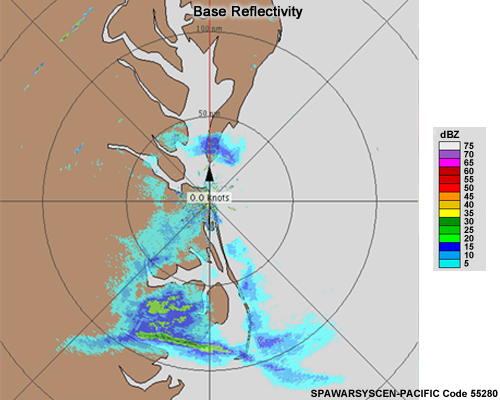Overview of Weather Radars » Types of Weather Radars

A National Weather Service NEXRAD tower and radome, which houses the antenna
Many types of radars are used to detect precipitation and other weather conditions. The most common ones used in the United States are those pulse radars that make up the National Weather Service's NEXRAD (NEXt Generation RADar) WSR-88D system and the less common, but more sophisticated, phased-array radars used mainly by the military and in atmospheric science research.
Typically, a NEXRAD WSR-88D radar antenna is pointed at a low angle, sends out a pulse for a fraction of a second, and then "listens" to receive any returning energy or "scattering." Then the radar rotates an incremental amount and repeats the process. Once the radar completes an entire revolution, the antenna elevation angle is increased and the process is repeated. Radars transmit and listen so quickly that they can scan much of the nearby atmosphere in about 5 minutes.

The National Weather Service is currently upgrading their pulsed radar network to dual-polarization radars. WSR-88D radars emit and receive pulses that have horizontal orientations. Dual-polarization radars also transmit and receive data in the vertical direction, providing a more complete picture of atmospheric targets.
This technology allows forecasters to:
- Identify non-weather targets more easily
- Differentiate rain, snow, and melting snow
- Detect when hail is present in a thunderstorm
- Detect debris lofted by strong tornadoes

Vertical cross-section view of dual-polarization reflectivity (top) and precipitation type (bottom). The bottom color scale progresses from light-moderate-heavy rain through rain/hail mix, graupel/sleet, hail, dry and wet snow, and ice.
Deployment of the systems began in 2011, and completion is expected in 2013. The new radar products, some of which may have limited availability to outside users, will have significant changes that are not discussed in this module. More information is available from the NWS Warning Decision Training Branch.

By contrast, phased-array radars do not have a single rotating antenna and instead direct electromagnetic pulses via arrays of many small antennas. Most have dual-polarization capabilities as well. This type of radar will likely replace the WSR-88D radars in the future.

Illustration of phased array scans including a scan through a cumulonimbus (cb) cloud; detection and tracking of aircraft; scan through the planetary boundary layer (clear air) for mapping winds; scan through a supercell storm; and long-dwell scan through a region of a potential tornado
Because no mechanical rotation or inclination is involved, phased-array radars can scan much faster and in any specific area that is desired, such as an individual thunderstorm cell. They can also be used to scan multiple areas of interest simultaneously.

For most applications, the phased radar returns look quite similar to those of NEXRAD WSR-88D pulse radars and interpretation of them is very similar.